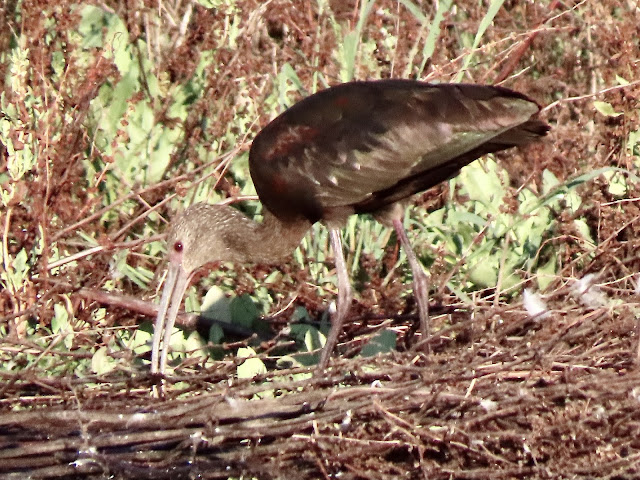Monday, September 20, 2021
Finally, the temperatures are dropping into the 70s at nighttime and lasting into the early hours of the morning. Cooling temps gives me a bit more incentive to head out to see what birds might be hanging out or migrating through.
Driving west for about fifteen minutes along with the 5:30 a.m.early commuter traffic, I am struck by the very full orange-colored moon setting in front of me. How can I get a photo? Can't do it from here; I'll need to wait until I reach the Water Ranch to see if it is still hanging above the horizon.
Lois pulls into the parking lot immediately after I do, so we head toward the fishing pond reeds to see if any of the LEAST BITTERNs are still there and coming out into the open a bit. First, we find birder friend, Lindsay, already at the location. She points out where one of the young bitterns is well camouflaged behind reeds. I take photos but have needed to open up the lens for so much light to come into the still dark reeds, that pictures were a bust.
Habitat is water-treatment ponds for final sewage filtration. Birds arrive in good numbers almost every month except the hottest ones of June, July, August.
Of the forty species we spotted in all the ponds, my photos were limited to ones that stood still!
On the fishing pond, along with domestic mallard interbreeds were some domestic MUSCOVEY DUCKS (Black & White; Brown; and perhaps young ones that stayed together)
We heard before seeing GREATER YELLOWLEGS
The one LESSER YELLOWEG was associating with but staying separate from the four GREATER YELLOWLEGS.
In the early-morning sun, the GREAT BLUE HERON appeared to be a bit washed out.
For some reason, BLACK PHOEBEs were calling from each and every pond. Normally, I see more of them at the river sites, but today, they were loving the Water Ranch.
Our best sighting was a WHITE-FACED IBIS, a fairly large wader at 27". Its long decurved bill finds crustaceans and other tasty tidbits in marsh waters. Because the "face" is marked with white feathers only in the breeding season, I called this bird a Glossy Ibis for a couple years when I first arrived in Arizona. As I would then find out, a Glossy Ibis is a big "find" here, as it is an east coast bird--the only one I knew at that time. Note its red eye.
The SNOWY EGRETs were feisty today. When they discovered the WHITE-FACED IBIS in their "territory" they began to have some "words."
Another SNOWY EGRET (note its "golden slippers") goes after a Mallard. The pond was crowded. I can relate; I like my space, too
Walking three miles at a leisurely pace looking for birds, coming upon other birders who shared their sightings, and having amazing numbers of birds already returning to the ponds, it was a delightful day.
For full list, check link below:
View this checklist online at https://ebird.org/checklist/S94930985
* * *










No comments:
Post a Comment